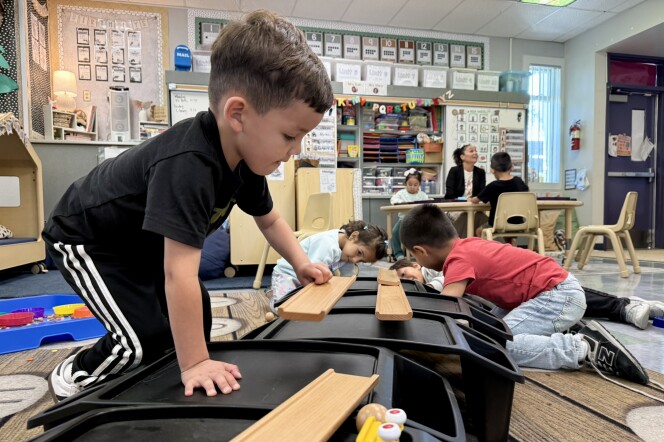Truth matters. Community matters. Your support makes both possible. LAist is one of the few places where news remains independent and free from political and corporate influence. Stand up for truth and for LAist. Make your year-end tax-deductible gift now.
New exhibit explores Japan’s hyper-realistic food replica culture

At the 49-year-old Little Tokyo restaurant Kouraku, potential diners can peruse a glass case lined with fake foods to preview what’s on the menu.
The display of shokuhin sampuru, or “sample foods,” spans half the restaurant’s East 2nd Street storefront and features life-size replicas of its most popular dishes.
A viscous brown gravy ladled atop the best-selling tenshin chahan ankake (shrimp omelette with pork fried rice) pools into a glossy moat, while the generously portioned mabo tofu includes heaps of delicate tofu cubes suspended from a serving spoon. The three-dimensional models look good enough to eat — and that’s exactly the point.

New exhibit
The tradition of shokuhin sampuru has been delighting Japanese diners and diasporic communities for over a century, and is the subject of a new exhibit at Japan House Los Angeles called “Looks Delicious!”
The exhibition, which is free to attend until Jan. 25, 2026, is the first of its kind to explore Japan’s food replica culture in the U.S., and was previously on display at Japan House London.
Eat with your eyes
Located within the Ovation Hollywood complex, Japan House Los Angeles’ bi-level campus includes an event space, gallery, library, gift shop and Michelin-starred kaiseki restaurant, Uka.
Looks Delicious! takes over the gallery, with seven distinct areas displaying different elements of shokuhin sampuru culture, from its origins, to its manufacturing and its adoption in restaurants and beyond.

Shokuhin sampuru first appeared in 1923 at one of Japan’s oldest department stores, Shirokiya, as a way to introduce Japanese diners to Western-style dishes (yōshoku) available in its dining hall.
Painted wax models cast from agar jelly molds enticed an unfamiliar audience to try dishes like spaghetti and hamburgers. The success of Shirokiya’s food replicas led to its widespread usage by other department stores and eventually by restaurants across Japan.
Today, well-made and prominently displayed food replicas continue to play an important role in bridging cultural and language barriers for international tourists visiting the country.

From old-school wax to modern plastic
While wax food models were sufficient during shokuhin sampuru's earliest iterations, their limited range of textures and colors, as well as their sensitivity to heat and light, were improved upon with the introduction of silicon molds and synthetic resins in the 1970s.
Sturdier materials, coupled with skilled artisans dedicated to hand-painting foods in painstaking detail, transformed what was originally considered practical marketing tools into genuine works of hyper-realistic art.
Beyond its functional purpose, shokuhin sampuru underscores the importance of hospitality and manufacturing within Japanese culture.
“Of course, it had a business commercial intention, but it was part of the spirit to provide hospitality, to make people feel comfortable,” said Yuko Kaifu, president of Japan House Los Angeles, “and also attention to detail; we call it monozukuri.”
Japan’s deeply rooted dedication and pride to craftsmanship, continuous improvement, and innovation are at the heart of shokuhin sampuru production.
Even with the proliferation of food photos online and on social media today, many restaurants in Japan continue to commission shokuhin sampuru, providing photographs and frozen versions of dishes to manufacturers to ensure accuracy of the replicas.
It can cost up to $10,000 to render an entire menu; however, more affordably priced generic food replicas are also available to restaurants for purchase.
On the culinary map
The centerpiece of the exhibit is a bounteous collection of specially commissioned food replicas from each of Japan’s 47 prefectures.
The northernmost prefecture of Hokkaido is represented by ohaw soup, a dish of game or fish simmered with seasonal wild mountain vegetables, traditionally made by the Ainu indigenous people. The fish filets’ shiny skin and delicate scales look lifelike under the gallery’s overhead lights.
In Aichi Prefecture, a replica of ogura toast consists of a plush slice of shoku-pan (Japanese white bread) daintily topped with sweet red bean paste and a thick pat of butter. Even simple mandarin oranges from Ehime Prefecture appear pristine, their skins supple and flesh appealingly juicy.
The exhibit is organized in collaboration with the Iwasaki, a group of three companies founded in 1932 by Iwasaki Takizō that produces the bulk of Japan’s food replicas (approximately 70 percent of market share). The commissioned food replicas for the exhibit were made by Iwasaki.
Rounding out Looks Delicious! are areas dedicated to celebrating Japanese confections (wagashi) and Edo-period snacks; an interactive build-your-own bento activity using an assortment of replica ingredients; and examples of shokuhin sampuru uses beyond restaurant marketing, including nutritional education.










